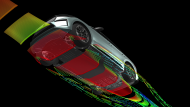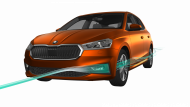Topic
Zdeněk Sloupenský – Škoda Auto: People wouldn’t like a perfectly aerodynamically shaped car
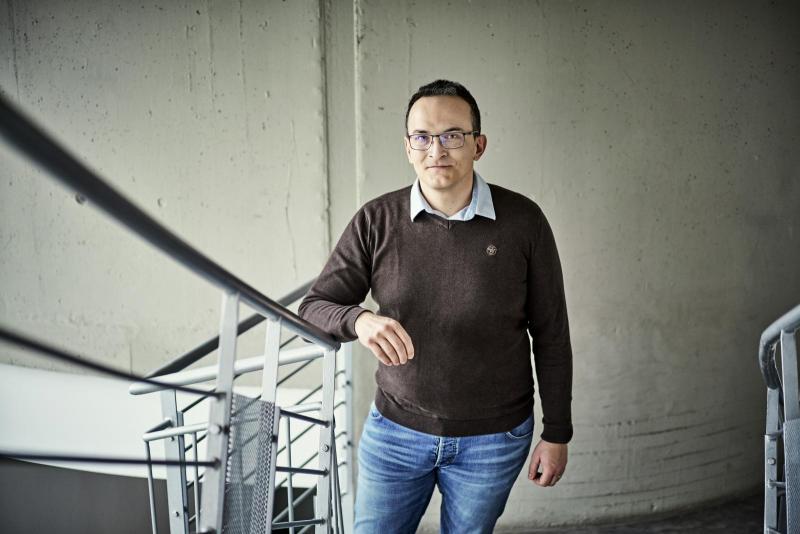
How do aerodynamics affect the safety of electric vehicles or their acoustics? Does a limousine or an SUV have lower air resistance? And how to modify the car body to travel a longer distance on a single charge? Zdeněk Sloupenský, a fluid engineer and graduate of FME (Faculty of Mechanical Engineering) BUT (Brno University of Technology), who has been leading the development of the external aerodynamics of Škoda Auto's electric vehicles for seven years now, knows the answers.
If aerodynamics was the only thing taken into account when designing a car - what would it look like?
It's the million-dollar question. You probably wouldn't buy that kind of car because it would be very close in shape to a raindrop or an airplane. It would be completely smooth, so that the air would flow nicely around it, and it would have a narrowed stern like a raindrop or a yacht – the so-called boat tailing. Smooth front end, low front end, rounded edges and shapes. A gradual run out, as is typical for racing boats.
I'm picturing it as long, rounded Cadillac.
Unfortunately not, because it would have covered wheels and no protrusions, including mirrors. It would be so low that you would have to lie in it while driving. No cabin, four people would lie behind each other to minimize air resistance.
Of course, aerodynamics is not the main factor in the development of the car. A car like this would be unsellable. It's a collaboration between aerodynamicists, designers and engineers. We solve production, technological, price and design requirements. We are looking for a compromise between function, feasibility and aesthetics. Most of the time, there is no single part of the car where we all agree unambiguously. (with a smile)
One of the most popular car categories today is the SUV. It's not likely to be popular with aerodynamicists, is it?
Limousines or even station wagons, where you can work nicely with the silhouette, are more aerodynamically favourable. From this point of view, off-road vehicles or smaller trucks are the most difficult. The SUV cars are very popular cars because they make people feel safe and spacious. But it's a big, tall and relatively angular car, which is harder to work with in aerodynamic terms. In addition, the frontal area plays a big role in the aerodynamics of cars – as the area increases, the overall drag increases linearly.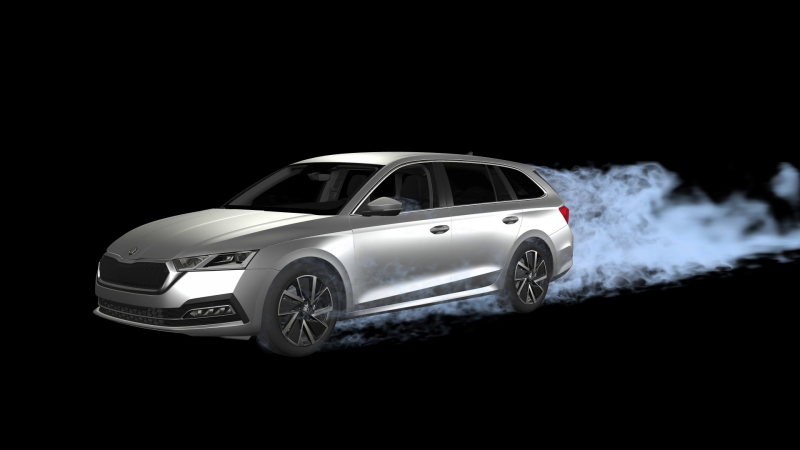
However, in developing the ENYAQ iV electric SUV, we took advantage of all the opportunities that were available to us. We have achieved a resistance value of 0.257 cd, which is a top value in this class of car and target segment. In the case of the ENYAQ Coupé iV, we have compressed the cd coefficient to 0.234 thanks to the flowing back.
What all affects the drag coefficient and how does it affect the driving experience?
It reduces air resistance and thus also reduces the amount of energy needed to power the car. This extends the range of the car on a single battery charge. For this model, one hundredth of a coefficient is approximately 7 km according to the WLTP cycle, which is the internationally recognised test standard for measuring fuel consumption. While driving on the motorway, this can be up to twice as much.
If you don't have other technical limitations, you can achieve a higher maximum speed. Aerodynamics is also being given more weight in the context of the introduction of CO2 limits. The car needs to be as efficient as possible and the customer needs to drive with the lowest possible consumption.
How specifically did you change the car from the previous model to make it work?
We played with the back silhouette of the car. We used the fact that electric cars allow us to have a fully covered floor. This is a great benefit in terms of aerodynamics. There was an exhaust on the older internal combustion cars that had to be cooled and therefore not covered. The air was stuck there, braking and changing direction. Electric cars don't have an exhaust, there's just a smooth battery that the air flows around better.
We also worked on the rear window slope and the spoiler, which affects the airflow behind the car. And because the wheels account for up to 25% of the car's air resistance, we added aerodynamic elements in front of the front wheels. We developed air curtains that take the air at the front of the bumper and direct it to the front wheel, whose disc we shaped with the design team. The wheels are smoothly wrapped and air resistance is reduced. It's one of the areas where you can gain a lot from aerodynamics.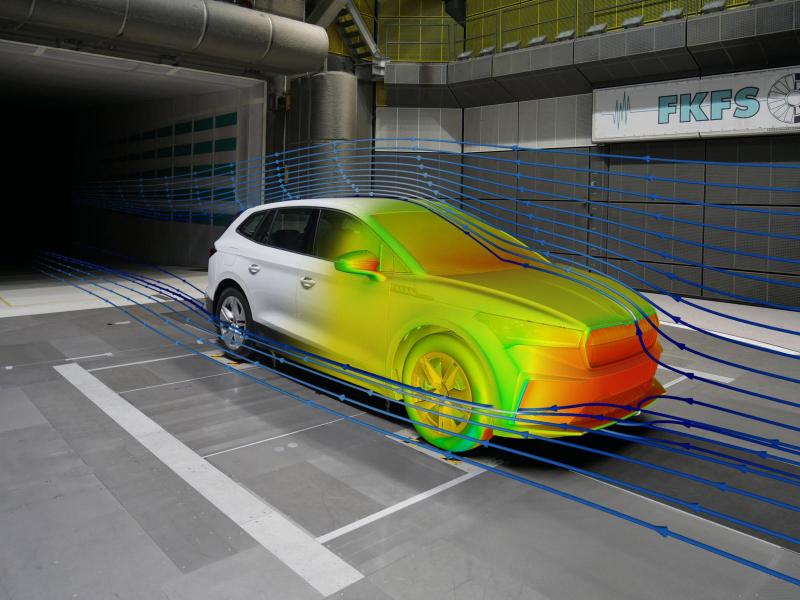
How does the actual development of the aerodynamics of the car work?
The development of the car takes about four years and for the first year and a half we calculate and develop everything on supercomputers. We are one of the best in virtual simulations. Škoda doesn't have its own wind tunnel, so we actually have to be one of the best. Only then we go to physically test the design of the car for the first time in the concern's wind tunnel. We call it – putting your foot down. And we are happy that our calculations are correct and only minor corrections are made.
It is interesting to note from the principle of aerodynamic simulations that the airflow cannot be described analytically. There is no equation by which you can always calculate the exact result. A system of non-linear equations is calculated. The virtual model of the space around the car is chopped into millions of small bricks in a virtual tunnel, inside which you iteratively calculate values expressing the state of the flow in each of them.
Does aerodynamics have any effect on the safety of the car?
Yes, and it is huge. We need to keep the car on the road even at top speed, when cornering at higher speeds or in contact with strong crosswinds. We must also take into account overtaking a truck or exiting a sound barrier or tunnel into the open. Therefore, we monitor not only the drag coefficient but also the lift coefficients. They show how much the front and rear axles are raised. In virtual simulations, we calculate the effect on the stability of the car during driving, which we also verify in the wind tunnel. We pass the data on to other teams who focus on getting the chassis set up correctly.
In aerodynamic development you also collaborate on aeroacoustics. What is it exactly?
Standard cars with combustion engines are quite noisy. The driver doesn't even realise that he doesn't hear a lot of things because of the engine noise. However, driving an electric car is quieter, so it is necessary to isolate passengers from the noise generated by, for example, wheel arches or tyres. They are suddenly much more audible and can disturb drivers.
Similarly, we try to isolate aerodynamic noise – the faster you go, the faster the air on the mirrors is torn away, for example. One of the concomitant effects of such a change in flow is the whistling and whirring that we hear in the cabin of the car. Together with our aeroacoustics colleagues, we added a turbulator to the ENYAQ iV mirror design. An element that optimizes the way air is drawn off and flows. The flow changes from laminar to turbulent. This also makes the car's mirror less noisy and more aerodynamically efficient.
What else are you going to work on at Škoda now?
We will definitely try to reduce the cd coefficient of air resistance in the next model of electric vehicle. And get a little over ourselves again. We generate up to 30,000 calculations and take hundreds of measurements in one year. It is not humanly possible to evaluate such a large amount of data, so supercomputers and advanced data analysis tools are coming into play to give us more room to push our capabilities.
In addition to the projects, I also lead the aerodynamics and aerodynamic measurements method development team, where we deal with building computational networks, flow simulation tools, as well as the development of measuring instruments and data analysis. For the last three years, we have been focusing on the use of artificial intelligence in the development process. We have to build some of the development tools from the ground up, and the results of working with those that include a certain AI algorithm are already reflected on some existing cars.
What are currently the biggest technological trends in aerodynamics?
A big technology trend that is emerging is the interconnection of the different fields of virtual development. Such as the aforementioned connection with aeroacoustics. In the individual disciplines we got very far, I would say somewhere on the edge. The next step is to share know-how and knowledge between the expertise. We are now dealing with the flow around and inside the car, but the next step will be to influence the shape of the plastic parts of the cooling air guide, where there is a direct link to the strength simulations. And there are many such examples that take the car's functionality further at relatively little cost.
I am personally proud of the work that we do here with other BUT graduates and not only with them. Our technologies are globally comparable, and not only in the field of fluid engineering.
(mar)
